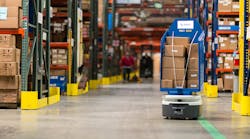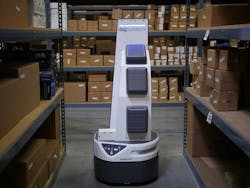Supply chain and fleet management expectations are growing as customer become more impatient to get their deliveries. Like the petulant Veruca Salt, we all "want it now!" We've become spoiled by Amazon's two-day turnarounds, though it seems like not that long ago we were fine with waiting six to eight weeks. In the future it could be six to eight hours. It's all being mandated by the customers, but it's being driven by innovations in robotics, Industry 4.0 and even wearables.
Seeing the need to leverage all the available tech possible, Ryder, a top-down supply chain solution provider, has taken the digital transformation to its operations in Miami, Dallas and Chicago, creating new smart warehouses. These sites will showcase advanced automation, flexible and instantly scalable operations, real-time visibility, and a customer-centric experience.
Ryder's data indicates the disruptive tech has shown real improvements already:
• Robotics: Deploying robots at one Ryder-managed warehouse produced a 25% increase in productivity and 20% operating savings by cutting employee travel time in the warehouse. This could absorb 30% of a worker's shift.
• Drones: At a Ryder customer warehouse, drones took 20 minutes to successfully scan pallets and locations, versus a manual scan that took 90 minutes.
• Sensors: Identification tools providing real-time asset location and enabling performance management implemented throughout a Ryder facility increased productivity and cost savings more than 25%
• Wearables: Smart glasses at a customer warehouse decreased picking time by five to seven seconds per item, improving efficiency by 33%.
“We are evaluating advanced technology and automation solutions that require minimum investment but deliver maximum return,” said Steve Sensing, Ryder President of Global Supply Chain Solutions. “We focus on technologies that are mobile, flexible, and scalable, so they can flex with changing demands. As Ryder customers continue to face increasing omni-channel fulfillment demands, rising consumer expectations, and a nationwide warehouse labor shortage, we will continue to innovate and automate the parts of the process that make sense.”
Ryder has partnered with Fetch Robotics, the maker of a cloud-based Autonomous Mobile Robot (AMR) to make this happen. The various models can do anything from hauling boxes in plastic pallets around a busy warehouse floor to tracking inventory with an RFID scanner, depending on the attached accessory. A collaborative robot with 7 DoF and interchangeable end effectors can be attached for various research applications.
“Together, our companies can provide autonomous mobile robot solutions to serve both warehouse employees and Ryder’s customers; ultimately making supply chain and logistics safer and more efficient. Our top priority is to help our customers achieve on-demand automation with a fast, flexible and scalable cloud-based platform that minimizes strenuous manual labor and streamlines inventory processes. We’re seeing this come to life successfully through the smart warehouses Ryder has developed.”
Finding out how to leverage these logistical technologies and solutions will be imperative to surviving this digital revolution, which is why Wise and Ryder CTO Gary Allen will be on hand at the Manufacturing & Technology Conference to talk about how to deliver end-to-end execution, control, and agility in your supply chain in a session called "Building Tomorrow's Smart Warehouses Today." For more info, visit www.mfgtechshow.com.













